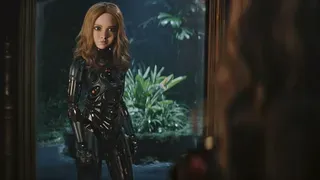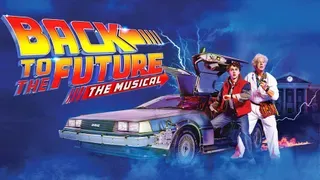November 5, 2014
Interstellar
Kilian Melloy READ TIME: 5 MIN.
Where science astounds, drama can easily fall flat. Where drama flourishes, on the other hand, science usually goes by the wayside as a matter of poetic license. It's not quite as hard to reconcile the two as, say, quantum physics and Einstein's Theory of Relativity; but rare is the science fiction film that takes root - and keeps root - in the gravelly loam of science fact while successfully generating a story that captures the attention and enchants the heart.
Christopher Nolan's much-anticipated film "Interstellar" tries nobly, but falls woefully short. The film labors under a self-imposed mandate to live up to the genre's high-water mark, Stanley Kubrick's masterpiece, "2001: A Space Odyssey." The shadow of that film manages to touch multiple aspects of "Interstellar," from elements of the production design to a general (and bombastic) sense of this being an Important Movie. Even the robots envisioned here (scissor-walking, sometimes spikily tumbling mobile supercomputers with names like KIPP and TARS) seem to owe something to "2001"'s Monoliths, and while there are some laugh lines designed to tease you with the idea that one of these lumbering mechanical helpers might go HAL-9000, the closest the robots come to posing a menace is to make lame jokes. That doesn't stop Nolan from shamelessly anthropomorphizing them.
But for every "2001"-worthy scene there are three or four that feel more akin to the genre's mediocrities: the disastrous Val Kilmer vehicle "Red Planet" comes most readily to mind. Here and there you'll note touches of "Contact," another film that sought -- more successfully than Nolan has managed -- to marry hard fact to flights of fantasy.
The thing is, if Nolan and brother Jonathan Nolan, with whom the director co-wrote the screenplay, hadn't tried so hard to be Epic and Important, with capital letters, they'd probably have created a much better movie. There's a sense of restraint here that serves the movie well, and a richly envisioned future, both on Earth and off. (Cinematographer Hoyte Van Hoytema could well take home the gold come Oscar night.)
It's a few decades into the future. A former NASA test pilot named Cooper (Matthew McConaughey) has become a farmer - as have many of Earth's survivors. Some unnamed catastrophe has decimated the planet's population (it could be famine, given that the world's food supply is systematically being destroyed by blight). Whatever the cause, the global disaster has led to a strange sort of utopia: There is no more war, because there are no more armies. Small town life and its attendant values seem to have reasserted themselves. But a few vestiges of the bad old days persist: Schoolbooks are "corrected" to contain falsifications of historic events, and energy is in short supply. Also, much of the country seems to have become a dust bowl, with gigantic dust storms rising periodically.
When Cooper's daughter Murph (Mackenzie Foy) starts noticing odd things happening - her books flying off the shelves, dust settling in strange patterns - McConaughey, in a leap of logic, determines that someone (or something) is trying to direct them to specific global coordinates. (Cue the "Close Encounters" nod.) What Cooper and Murph discover at those coordinates stuns them; let's just say, their discovery leads directly to a reconnection between Cooper and his old boss at NASA, Professor Brand (Michael Cane), who has a World-Saving Errand for Cooper: Fly a small crew of astronauts through a conveniently located wormhole near Saturn to a distant galaxy, where a small clutch of potentially habitable worlds await... some of them in proximity to a huge black hole dubbed "Gargantua."
Famed physicist Kip Thorne served as science advisor, but, recent media reports note, it was the movie's visual effects team that made a new discovery. Using the math Thorne supplied, the CGI modelers found that a massive black hole like Gargantua would warp light into both a ring and a halo. (The delighted Thorne has said he expects to generate a couple of scientific papers from their discovery.) So much the better for the visuals, which are seamless and all-encompassing, especially in IMAX.
But the film falls as inexorably into familiar narrative grooves as matter siphoned off Gargantua's companion star spirals into the black hole's gravity well. Brand's beautiful, intelligent daughter, Amelia (Anne Hathaway), is part of the flight team. Cooper's daughter Murph (Mackenzie Foy as a 10-year old; Jessica Chastain as an adult), remains on Earth, harboring intense abandonment issues and aging naturally while relativistic effects keep her father youthful. Improbably, Murph grows up to become part of Professor Brand's research team. Meantime, across the universe, natural disasters, human failings, and zero-gravity accidents (think "Gravity," with its debris clouds and shredded space craft) hammer at Cooper and company. There's even an incident that involves a short planetary landing, with a serious time differential coming into play - the science is sound, but way it's played seems like something from "Star Trek" or even "Red Dwarf."
Meantime, extraneous sub-plots bog the film down and bloat it, which is irritating, given its nearly three-hour running time. Matt Damon crops up on an ice planet; why? The entire excursion feels like padding, and could have been lost with no significant harm to the essential plot. Casey Affleck plays Cooper's grown son, himself struggling with family issues that are given such short shrift that what remains of his story feels vestigial and ripe for total excision.
All this would be bearable if "Interstellar" didn't suffer from a compulsion to explain -- rather, to talk circles around -- everything. Moreover, the film suffers from "tied up in a bow" syndrome, such that its mysteries (Who put the wormhole there? Who seems to be guiding and even protecting our heroes?) are given an easy to swallow (but impossible to digest) explanation that, when you think about it, goes beyond silliness.
Nolan likes to dream big, and he likes to create films that are packed with action - so packed that he resorts, sometimes, to parallel narratives, as he did with "Inception," where he cut back and forth between realities nested into one another. He attempts something similar here, while simultaneously reaching for the brass ring of a Big Philosophical Statement (again, his intentions feel capitalized), but the relationships between various plot threads are fuzzy and the cuts from one unfolding drama to the other are muddled. Most disappointing is the finale: You can sense Nolan bursting to match Kubrick's eerie, effortless combination of the familiar and otherworldly, but there's nothing doing. The pipe organ-heavy soundtrack by Hans Zimmer is especially disappointing, giving the film a funereal (rather than majestic) mood.
This film soars briefly, here and there, but only in the way a skipping stone soars between splashes. The rest of the time, it's very pretty to look at... but it's also pretty soggy going.
Kilian Melloy serves as EDGE Media Network's Associate Arts Editor and Staff Contributor. His professional memberships include the National Lesbian & Gay Journalists Association, the Boston Online Film Critics Association, The Gay and Lesbian Entertainment Critics Association, and the Boston Theater Critics Association's Elliot Norton Awards Committee.







